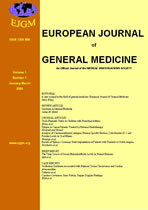
|
European Journal of General Medicine
Medical Investigations Society
ISSN: 1304-3897
Vol. 4, Num. 1, 2007, pp. 56-57
|
European Journal of General Medicine, Vol. 4, No. 1, 2007, pp. 56-57
BRIEF REPORT
SANDIFER SYNDROME
Sinan Akbayram1, Murat Doğan1, Serpil Turhan2, Hüseyin Çaksen2
Yuzuncu Yil University, Faculty of Medicine, Department of Pediatrics1, Van, Numune Training and Research Hospital, Department of Biochemistry2, Ankara,Turkey
Correspondence: Hüseyin Çaksen, MD, Yuzuncu Yil University, Faculty of Medicine, Department of Pediatrics, Van, Turkiye, Tel: 904322176128, fax: 904322150479, E mail: huseyincaksen@hotmail.com
Code Number: gm07014
Sandifer syndrome is an uncommon clinical entity characterized by gastroesophageal reflux, torticollis and paroxysmal dystonic postures. For the wide variability in clinical expression it is diagnosed as neurological disease (1-3). Herein, we report a case of Sandifer syndrome because of overlooked in clinical practice.
A 2-year-old boy was admitted with cough and vomiting for 1 week. His mental and motor developmental milestones were normal. He had no history of systemic disorder previously. The family history was also unremarkable. On physical examination the weight and height were 8700 g (below the 3rd percentile) and 82 cm (10th percentile), respectively. He had pallor, mild hepatosplenomegaly and bilateral inspiratory rales. The head was tipped toward to right side and the chin rotated toward the other (torticollis). On laboratory investigation, urinary analysis was normal. Hemoglobin and white blood cell count were 6.7 g/dL, 26,700/mm3, respectively. Peripheral blood smear revealed predominant of polymorphonuclear leukocytes. Roentgenogram of the chest showed pneumonic infiltration on the right perihiler, and paracardiac regions. Barium esophagogram showed gastroesophageal reflux. The patient was given penicillin, and chloramfenicol for 10 days to treat bronchopneumonia.
Sandifer syndrome, opisthotonos, and other abnormal head posturing, are associated with reflux. The head positioning may be a mechanism to protect the airway or reduce acid-reflux-associated pain. The diagnosis may be overlooked if symptoms are mild. Neurologic disorders are often suspected. Exhaustive and expensive neurologic examinations may be unnecessary. Early diagnosis allows prompt treatment and resolution of the problem. Medical management is usually successful. Methylxanthines may exacerbate reflux by lowering sphincter tone. Metoclopramide reduce symptoms by stimulating gastric emptying and esophageal motility. (4-9). In conclusion we suggest that infants or children with torticollis, dystonic posturing or atypical seizures should be evaluated for Sandifer syndrome.
REFERENCES
- Greco F, Finocchiaro M, Spina M, Rotolo N, Incorpora G. Sandifer’s syndrome: a rare form of torticollis in childhood. A report of a patient]. Pediatr Med Chir 1997;19:227-30
- Werlin SL, D’Souza BJ, Hogan WJ, Dodds WJ, Arndorfer RC. Sandifer syndrome: an unappreciated clinical entity. Dev Med Child Neurol 1980;22:374-8
- Senocak ME, Arda IS, Buyukpamukcu N. Torticollis with hiatus hernia in children. Sandifer syndrome. Turk J Pediatr 1993; 35:209-13
- Deskin RW. Sandifer syndrome: a cause of torticollis in infancy. Int J Pediatr Otorhinolaryngol 1995;32:183-5
- Nanayakkara CS, Paton JY. Sandifer syndrome: an overlooked diagnosis? Dev Med Child Neurol 1985;27:816-9
- Gorrotxategi P, Reguilon MJ, Arana J, Gaztanaga R, Elorza C, de la Iglesia E, Barriola M.Gastroesophageal reflux in association with the Sandifer syndrome. Eur J Pediatr Surg 1995 5:203-5
- Loureiro B, Ferrer-Lozano M, Abenia P, Ferraz S, Rebage V, Lopez-Pison J. Torticollis as a cause of consultation in neuropediatrics Rev Neurol 1999;29: 493-9
- Herbst JJ. The esophagus. In: Behrman RE, Kliegman RM, Jenson HB, eds. Textbook of Pediatrics. 16th ed. Philadelphia: WB Saunders, 2000;1121-8
- Frankel EA, Shalaby TM, Orenstein SR. Sandifer syndrome posturing: relation to abdominal wall contractions, gastroesophageal reflux, and fundoplication. Dig Dis Sci 2006;51: 635-40
Copyright 2007 - Medical Investigations Society
|
